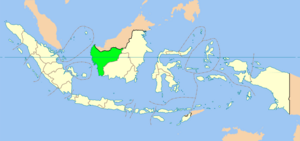West Kalimantan facts for kids
West Kalimantan, known as Kalimantan Barat in Indonesian, is a province in Indonesia. It is located on the island of Borneo, which is shared with Malaysia and Brunei. West Kalimantan is one of five Indonesian provinces on this large island. Its capital city is Pontianak. The province covers an area of about 147,307 square kilometers (56,875 square miles). In 2014, about 4.5 million people lived there.
Quick facts for kids
West Kalimantan Province
Provinsi Kalimantan Barat
کاليمانتان بارت 西加里曼丹 |
|||
|---|---|---|---|
|
|||
| Nickname(s):
Provinsi Seribu Sungai
Province of Thousand Rivers |
|||
| Motto(s):
Akçaya (Sanskrit)
(Immortal) |
|||

Location of Province of West Kalimantan in Indonesia
|
|||
| Country | |||
| Capital | |||
| Area | |||
| • Total | 147,307 km2 (56,876 sq mi) | ||
| Area rank | 3rd | ||
| Population
(2014)
|
|||
| • Total | 4,546,439 | ||
| • Density | 30.86370/km2 (79.93662/sq mi) | ||
| Demographics | |||
| • Ethnic groups | Dayak (32.75%), Malay (29.75%), Chinese (29.21%), Javanese (5.25%), Bugis (0.3%) Others (9.85%) | ||
| • Religion | Islam (51.22%), Roman Catholicism (23.94%), Protestantism (12.38%), Buddhism (12.21%), Confucianism (1.68%), Hinduism (0.06%) | ||
| • Languages | Indonesian (official), Malay (Pontianak Malay, Sambas Malay), Dayak (Iban, Kendayan, Jangkang, Bukar Sadong etc.), Chinese (Hakka, Teochew) | ||
| Time zone | UTC+7 (WIB) | ||
| Vehicle registration | KB | ||
| HDI | |||
| HDI rank | 28th (2014) | ||
| Website | www.kalbarprov.go.id | ||
Contents
People and Culture in West Kalimantan
West Kalimantan is home to many different groups of people. The largest groups are the Dayak and the Malay. The Dayak people make up about 32.75% of the population, and the Malay people are about 29.75%. There are also many Chinese people, making up about 29.21% of the population. Other groups include the Javanese and Bugis people.
Languages Spoken in the Province
The official language in West Kalimantan is Indonesian. However, many other languages are spoken daily. These include different types of Malay, like Pontianak Malay and Sambas Malay. Many Dayak languages are also spoken, such as Iban, Kendayan, and Jangkang. Chinese languages like Hakka and Teochew are common too.
Religions in West Kalimantan
People in West Kalimantan follow various religions. The main religion is Islam, followed by over half the population (51.22%). A large number of people are Christian, including Roman Catholics (23.94%) and Protestants (12.38%). Other religions practiced include Buddhism (12.21%), Confucianism (1.68%), and Hinduism (0.06%).
| Religion in West Kalimantan | ||||
|---|---|---|---|---|
| religion | percent | |||
| Islam | 51.22% | |||
| Christianity | 36.32% | |||
| Buddhism | 12.21% | |||
| Confucianism | 1.68% | |||
| Hinduism | 0.06% | |||
Geography and Nature
West Kalimantan is known as the "Province of a Thousand Rivers" (Provinsi Seribu Sungai). This is because many rivers flow through the region. These rivers are important for travel and trade.
Danau Sentarum National Park
One special natural area in West Kalimantan is Danau Sentarum National Park. This park is a very important wetland. Wetlands are areas where water covers the land, like swamps or marshes. Danau Sentarum is recognized internationally for its unique environment and wildlife.
History of Pontianak Sultanate
The capital city, Pontianak, has a rich history. The Pontianak Sultanate was founded here. The first building built to celebrate the start of the Sultanate was the Masjid Jami' Pontianak. This mosque was built in 1771 along the Kapuas River. It shows a mix of local Malay-Muslim, Middle Eastern, European, and Javanese building styles.
Images for kids
-
Masjid Jami' Pontianak, originally built in 1771 on the banks of Kapuas River. It was the first structure built to commemorate the foundation of Pontianak Sultanate.
See also
 In Spanish: Provincia de Borneo Occidental para niños
In Spanish: Provincia de Borneo Occidental para niños







